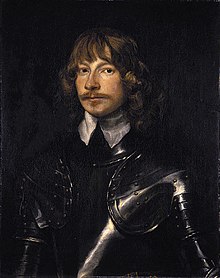
Back جيمس غراهام Arabic James Graham, Ardalydd 1af Montrose Welsh James Graham, 1. Marquess of Montrose German James Graham, I marqués de Montrose Spanish جیمز گراهام، اولین مارکز مونتروز Persian James Graham (1er marquis de Montrose) French James Graham, I marchese di Montrose Italian ジェイムズ・グラハム (初代モントローズ侯爵) Japanese James Graham (1e markies van Montrose) Dutch Грэм, Джеймс, 1-й маркиз Монтроз Russian
The Marquess of Montrose | |
|---|---|
 Portrait by Anthony van Dyck, 1636 | |
| Born | 1612 Scotland |
| Died | 21 May 1650 (aged 37) Mercat Cross, Edinburgh, Scotland |
| Cause of death | Execution by hanging |
| Resting place | St. Giles' Cathedral, Edinburgh, Scotland |
| Nationality | Scottish |
| Other names | The Great Montrose |
| Alma mater | University of St Andrews |
| Occupation(s) | Chief of Clan Graham, soldier, poet |
| Title | Lord Lieutenant and captain-general of Scotland, 1st Marquess of Montrose, 5th Earl of Montrose |
| Spouse | Magdalene Carnegie |
| Children | James Graham, 2nd Marquess of Montrose |
| Parent(s) | John Graham, 4th Earl of Montrose Margaret Ruthven |
| Military career | |
| Battles / wars | |
| Signature | |
James Graham, 1st Marquess of Montrose (1612 – 21 May 1650) was a Scottish nobleman, poet, soldier and later viceroy and captain general of Scotland. Montrose initially joined the Covenanters in the Wars of the Three Kingdoms, but subsequently supported King Charles I as the English Civil War developed. From 1644 to 1646, and again in 1650, he fought in the civil war in Scotland on behalf of the King. He is referred to as the Great Montrose.
Following his defeat and capture at the Battle of Carbisdale, Montrose was tried by the Scottish Parliament and sentenced to death by hanging, followed by beheading and quartering. After the Restoration, Charles II paid £802 sterling for a lavish funeral in 1661. Montrose's reputation later changed from traitor or martyr to a romantic hero and subject of works by Walter Scott and John Buchan.[1] His spectacular victories, which took his opponents by surprise, are remembered in military history for their tactical brilliance.[2]
- ^ Bennett, Rachel (2017). "'A Candidate for Immortality': Martyrdom, Memory, and the Marquis of Montrose". In McCorristine, S. (ed.). Interdisciplinary Perspectives on Mortality and its Timings. Palgrave Historical Studies in the Criminal Corpse and its Afterlife. London: Palgrave Macmillan. pp. 33–47. doi:10.1057/978-1-137-58328-4_3. ISBN 978-1-137-58328-4.
- ^ "James Graham, 5th Earl and 1st Marquess of Montrose". Encyclopædia Britannica. Retrieved 23 June 2013.